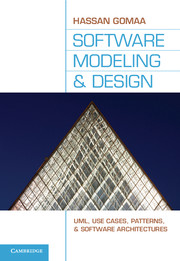Book contents
- Frontmatter
- Contents
- Preface
- Annotated Table of Contents
- Acknowledgments
- PART I Overview
- PART II Software Modeling
- PART III Architectural Design
- PART IV Case Studies
- 21 Client/Server Software Architecture Case Study
- 22 Service-Oriented Architecture Case Study
- 23 Component-Based Software Architecture Case Study
- 24 Real-Time Software Architecture Case Study
- Appendix A Catalog of Software Architectural Patterns
- Appendix B Teaching Considerations
- Glossary
- Answers to Exercises
- Bibliography
- Index
23 - Component-Based Software Architecture Case Study
from PART IV - Case Studies
Published online by Cambridge University Press: 05 June 2012
- Frontmatter
- Contents
- Preface
- Annotated Table of Contents
- Acknowledgments
- PART I Overview
- PART II Software Modeling
- PART III Architectural Design
- PART IV Case Studies
- 21 Client/Server Software Architecture Case Study
- 22 Service-Oriented Architecture Case Study
- 23 Component-Based Software Architecture Case Study
- 24 Real-Time Software Architecture Case Study
- Appendix A Catalog of Software Architectural Patterns
- Appendix B Teaching Considerations
- Glossary
- Answers to Exercises
- Bibliography
- Index
Summary
This chapter describes how the COMET software modeling and architectural design method is applied to the design of a component-based software architecture: an Emergency Monitoring System.
The problem description is given in Section 23.1. Section 23.2 describes the use case model for the Emergency Monitoring System. Section 23.3 describes the Emergency Monitoring System static model, covering static modeling of both the system context and entity classes. Section 23.4 describes dynamic modeling, in which communication diagrams are developed for each of the use cases. Section 23.5 describes the design model for the Emergency Monitoring System, which is designed as a layered architecture based on the Layers of Abstraction pattern combined with the client/service pattern and several architectural communication patterns. Section 23.6 describes software component deployment.
PROBLEM DESCRIPTION
An Emergency Monitoring System consists of several remote monitoring systems and monitoring sensors that provide sensor input to the system. The status of the external environment is monitored with a variety of sensors. Some of these sensors are attached to remote monitoring systems, which send regular status input that is stored at a monitoring service. In addition, from the sensor information, alarms are generated concerning undesirable situations in the external environment that require human intervention. Alarms are stored at an alarm service. Monitoring operators view the status of the different sensors and view and update alarm conditions.
USE CASE MODELING
This section describes the use case model for the Emergency Monitoring System. From the problem description, three actors are determined.
- Type
- Chapter
- Information
- Software Modeling and DesignUML, Use Cases, Patterns, and Software Architectures, pp. 453 - 471Publisher: Cambridge University PressPrint publication year: 2011



